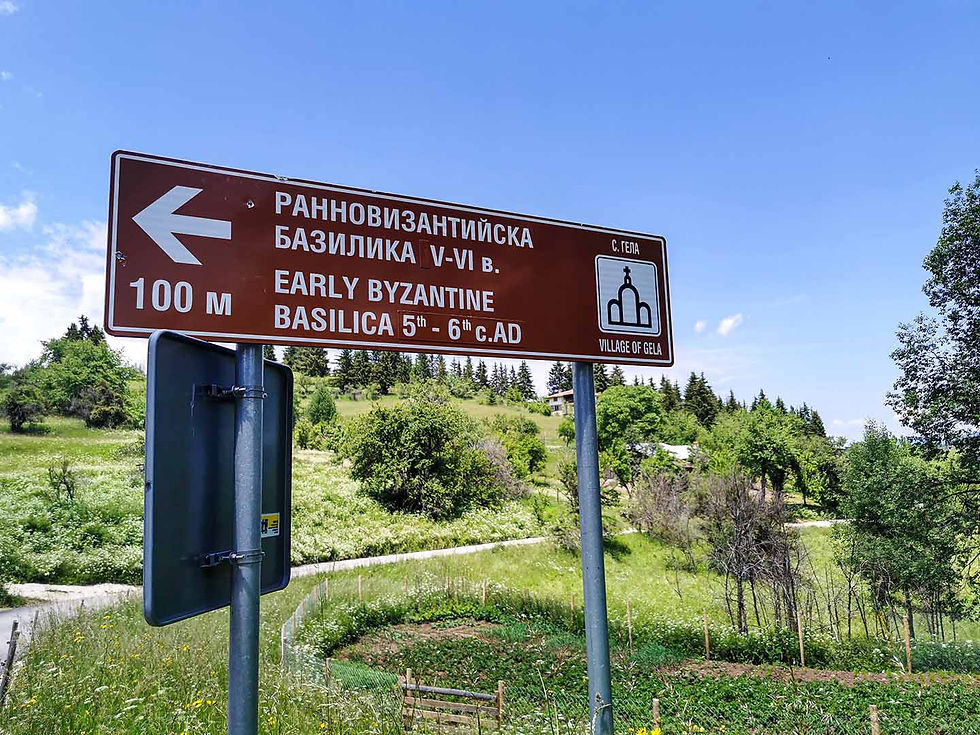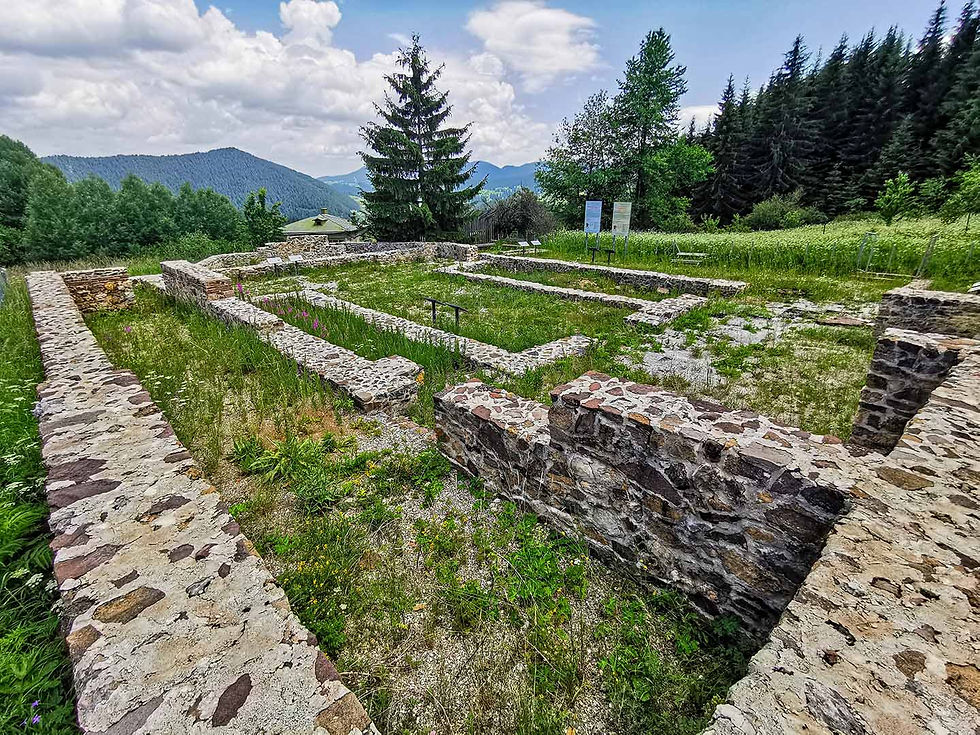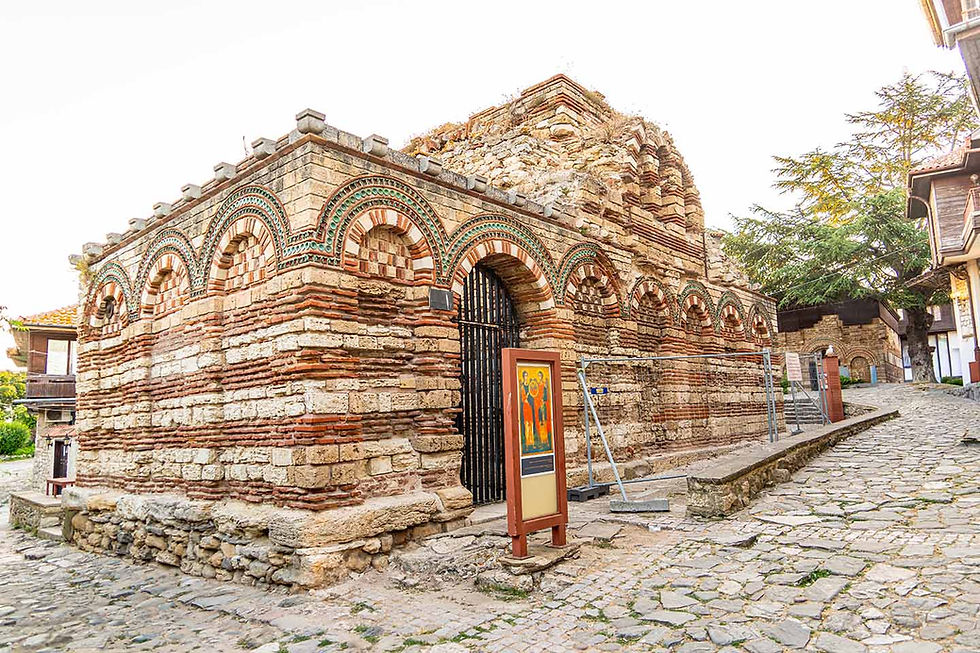Early Byzantine basilica in the village of Gela
- Stefan Ivanov

- Oct 5, 2022
- 7 min read
Updated: Jan 20
Dear travelers, dear discoverers, I present to you the impressive ruins of an early Byzantine basilica, located in the area of Manastira in the village of Gela amidst immense beauty and majestic views.

I am in the heart of the exquisite and incomparable charm of the Rhodopes.
Their beauty surrounds me from all sides!
I feel an immeasurable and overwhelming calm here!

Unsurpassed green charm hides this pristine Rhodope area - here I feel alive and in unity and harmony with the charming and astonishingly beautiful nature surrounding me, like nowhere else!

Walking among this beauty, I arrive in front of the Holy Trinity Church, where I am greeted by this sign:

How do you get to the village of Gela and the Holy Trinity Church, the starting point for today's adventure?
The starting point is the beautiful and so musical village of Shiroka Laka. From the center of the village, take the direction of the National School of Folk Arts "Shiroka Laka", passing it, you leave the village.
About 300 meters down the road, watch for a turnoff to the right.
The road to the village of Gela is good. The distance to the village is about 8 kilometers.
Arriving in Gela, continue straight along the main road until you pass the Orthodox church "St. Bogoroditsa", located on a height by the side of the road.

Immediately after the church, take the left turn, following the signs indicating the way to the Church of the Holy Trinity and to the Early Byzantine Basilica. The road is narrow but very good.
You will arrive in front of "Sveta Troitsa", looking to the left for a small and narrow peculiar parking lot where you can leave your car.
The ruins of the basilica are located directly opposite the Temple of the Ascension and about a two-minute walk away.

From the parking lot in front of the temple to the ruins of the basilica leads a small, narrow and almost imperceptible path, overgrown with greenery in the summer.

I embark on it, completely unaware of the adventure that awaits me!

The day is excellent for travel!
The sun is high in the sky, which is turning azure blue, and only a few white clouds give it a fluffier appearance.

A few wooden benches await me here – begging me to rest my sea legs on them, but the explorer in me rushes to examine the majestic remains of a past irretrievably gone.
Many informative signs with a rich history in Bulgarian and English begin their interesting story about the beginning of the spread of Christianity in our lands. You will also read them if you follow the special photo album at the end of the journey.
The ruins are more than impressive!

The early Byzantine basilica near the village of Gela is the highest located (at 1480 meters above sea level) basilica of this type in the whole of South-Eastern Europe, and most likely it was part of a larger complex, whose main task was to spread Christianity among the Thracian tribes that inhabited the central Rhodopes at that time (V - VI century AD).
I carefully go around the site and photograph everything from everywhere.
The basilica was built in the fifth century AD. It probably existed for a short period of time - only about 200 years.
It was a beautifully decorated and richly ornamented building, erected at a time when the Roman Empire was actively enforcing the new Christian faith.
In 1910, the locals built a new church in the area - the "Holy Trinity" temple. During its construction, stones from the basilica, which is located directly opposite it, were used.
It was at this time that interest arose in exploring this place steeped in ancient history.

The early Byzantine basilica is three-aisled, single-apsed and had two entrances. It probably had windows, as a large number of glass fragments were found - thin and straight. The floor was covered with flagstones and the roof was most likely a wooden structure covered with tiles.
Of particular interest are the two open graves, as well as the traces of a huge representative building with rich decorations.

Unfortunately, over the years, the graves have been looted by treasure hunters, but according to locals, a golden Byzantine coin was found in one of them, placed in the mouth of a skull.
In Gela they ferment milk with a coin of Emperor Justinian I the Great
Emperor Justinian I the Great was an able and far-sighted ruler who ruled from 527 to 565, during which time he began the transformation of the late antique Eastern Roman Empire into early medieval Byzantium.

In one grave, the remains of a senior cleric were found, buried in a sitting position. A bishop's staff was found in the second grave, which unfortunately has not survived to this day.
One of the legends I came across says that the last patriarch of the Second Bulgarian State (1187 - 1396) was laid to rest here.

And here I will allow myself to take you back to those particularly troubled and so distant times, when the Kingdom of Tarnovo fell (1393).
...the barbarian king...suddenly attacked the city—not from one or two sides, but surrounding it on all sides with crowds of men.
Grigory Tsamblak
Tsar Ivan Shishman is not in the capital and Patriarch Evtimii Turnovsky is leading its defense.
The Ottoman enslavers, invading Tarnovo, found themselves face to face with the Bulgarian patriarch, who still kept alive the spirit of the people.
The leader Suleiman Celebi was afraid of the power of the patriarch and therefore decided to destroy him. That is why they took Euthymius to the Frontal Rock of the capital Tsarevets, to publicly cut off his head. Legend has it that the indomitable clergyman walked proudly, mourning only for his scorned people.
When the moment comes and the gelatin swings the sword over the father's head, his hand turns to stone. Everyone takes this as an omen!
Patriarch Euthymius of Turnovski was pardoned and sent into exile.
The touching parting of Euthymius with the Bulgarian people is well known!

He was exiled to the Bachkovo Monastery.
On their way, the Ottomans passed through the lands of today's Patriarch Evtimovo village.
The priest, all chained up, stays overnight in the area.

What words he whispered to the locals, no one knows, but one thing is indisputable - the Holy Spirit in Euthymius sowed the seeds of pure patriotism in this fertile Bulgarian land, and no one has ever succeeded in uprooting them, despite the merciless and inhuman trials, despite the persecutions, barbarism and vicissitudes of time.
After the Liberation in honor of the great enlightener, who also left his mark in the history of the village, it was renamed and today bears the name of Patriarch Evtimovo.

Perhaps the most widely accepted among all is the hypothesis that the path of exile of Patriarch Evtimij Tarnovski ends in the Bachkovo Monastery, where he worked until the end of his life, and then he was buried under the bell tower of the "St. Archangels" church.
It's incredible, but there are also a number of other legends, one of which is connected to the very place I'm telling you about today.
According to her, due to the concerns of the Greek bishops ruling over the Bachkovo Monastery at the time, and due to the immediate threat to the patriarch's life, he was taken away from there. Legend has it that it was he who was buried here in a sitting position, together with a scepter with a golden handle, around which two snakes of ivory were wrapped, a golden crown, and in his mouth a gold coin of Emperor Justinian I, was a very important and noble cleric.
The old people of Gela claim that their parents saw this scepter and that the buried clergyman was the last patriarch of the Second Bulgarian State.
Who can say what the truth really is?
With extreme caution, I step past the clay jars buried in the ground. Some are empty, others are filled with water from the rains that have fallen. I pick up a capstone with my hand and look inside, then very carefully put it back in its place.
The basilica probably lasted until the end of the sixth century. The ceramic fragments of vessels, parts of bricks and tiles, fragments of window glass, parts of glass cups and lamps, iron nails of different sizes, parts of fastening elements - rings, latches, clasps, as well as one copper female ring of unspecified date.
It was burned during one of the numerous Slavic invasions. After that, it was not restored in the same place.
The early Byzantine basilica has been declared a cultural monument of national importance.
At the end of our journey, I would like to remind you that you must visit the picturesque village of Gela and take a walk through the phenomenally beautiful fields around.
I wish you an excellent walk!




Comments